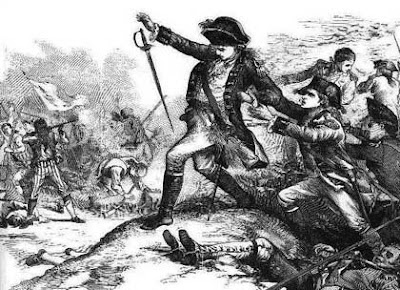The Growing Memory of Peter Salem
 As I noted a couple of days ago, the first history of Framingham published after Peter Salem died there said nothing about the town native fighting at Bunker Hill, much less shooting Maj. John Pitcairn. Elsewhere in New England, other men or families appear to have been making their own claims to having killed the British Marines commander.
As I noted a couple of days ago, the first history of Framingham published after Peter Salem died there said nothing about the town native fighting at Bunker Hill, much less shooting Maj. John Pitcairn. Elsewhere in New England, other men or families appear to have been making their own claims to having killed the British Marines commander.
Within a couple decades, however, histories were not only naming Salem as Pitcairn’s slayer, but they were illustrating his feat. The picture above first appeared in William Cooper Nell’s The Colored Patriots of the American Revolution (1855), though this version comes from Edward A. Johnson’s A School History of the Negro Race in America (1890). It’s clearly derived from John Trumbull’s painting The Death of General Warren, with the dramatic young white man standing in front of Salem on the canvas shooed out of sight.
Nell’s book was not only a pioneering work of African-American history; it was also part of the Abolitionist argument for emancipation and equal rights for black Americans. Nell and other authors used the story of Peter Salem as evidence of black contributions to the U.S. of A.
Abolitionists worked, against some indifference or hostility, to preserve the memory of that soldier. For example, Theodore Parker wrote to the historian George Bancroft on 16 Mar 1858:
In the engravings of the battle when I was a boy, the black man, Peter Salem, appears in the act of shooting Major Pitcairn; but now-a-days a white man is put in his place. Richard Frothingham, in his account of Bunker Hill battle, makes no mention of Peter. He appears, however, on some of the bills [i.e., currency] of the Monument, Freeman’s and Charlestown Banks.Eventually, in the same way that Crispus Attucks became better known than other Boston Massacre victims, so Peter Salem became better known than most other veterans of Bunker Hill. They served as defiant symbols of African-American patriotism.
The engraving below, captioned “The shooting of Major Pitcairn (who had shed the first blood at Lexington),” was published by Benson J. Lossing in the late 1800s. Lossing was selling books, not promoting Abolitionism, but by that point he and his engraver had to depict the man who shot Pitcairn as black. It was part of standard American history.
 Abolitionists also pointed to Salem Poor, an African-American recognized in 1775 as having fought especially well at Bunker Hill. But because it’s not clear what Poor had actually done to earn officers’ praise, his story never gained as much traction. (No doubt because of that vacuum, a story much like Peter Salem’s developed around Salem Poor, as I described back here.)
Abolitionists also pointed to Salem Poor, an African-American recognized in 1775 as having fought especially well at Bunker Hill. But because it’s not clear what Poor had actually done to earn officers’ praise, his story never gained as much traction. (No doubt because of that vacuum, a story much like Peter Salem’s developed around Salem Poor, as I described back here.)Those two men became symbols for many more non-white men who fought with the provincial forces early in the Revolutionary War—over a hundred documented in George Quintal’s report Patriots of Color. It’s easier for us to remember individuals with names than to remember large groups.
Finally, while researching this series of postings, I realized that a third name has become linked to the death of Maj. Pitcairn. In a footnote in The First Year of the American Revolution (1934), Allen French suggested that the American with the best claim to having killed Pitcairn was “Salem Prince, a negro.” That name appeared subsequently in Richard Ketchum’s Decisive Day, John Jakes’s Rebels, David H. Fischer’s Paul Revere’s Ride, and A. J. Langguth’s Patriots. Some websites now say that Salem Prince was, like Salem Middlesex, simply another name for Peter Salem.
However, Quintal found no record of any soldier named Salem Prince in the provincial army in 1775. And I can’t rouse any mention of a “Salem Prince” through Google Books before French’s footnote. I fear it was a simple error that’s now muddied the waters, which were never clear to begin with.
TOMORROW: My conclusions about who killed Maj. John Pitcairn.

1 comment:
J.L. I have been busy this week and finally caught up reading all your entries for the week. I think the conclusion will likely be that the shooter of Maj.Pitcairn will be a composite of Salem Poor, Salem Prince, or Peter Salem. I tend to think they are muddled together and actually the same person as you suggest. Still no clarification of the foru bullet theory though? c
Post a Comment